Close

In a decisive move to strengthen grassroots commerce and support local economies, the Government of Guyana has delivered on its promise to modernize key market infrastructure across Region 3 (Essequibo Islands–West Demerara). The comprehensive rehabilitation of the Leonora and Parika markets has brought tangible benefits to more than 800 vendors, while simultaneously improving the trading experience for thousands of consumers. This effort marks a pivotal step toward dignifying informal trade and fostering sustainable development in one of the country’s most economically active regions.
The Leonora Market, a long-standing commercial hub on the West Coast of Demerara, underwent structural upgrades including improved roofing, sanitation facilities, enhanced drainage, and organized vendor stalls. These changes have significantly elevated the market’s functionality, safety, and hygiene. At Parika, a major gateway to the Essequibo River and a nucleus of agricultural trade, similar rehabilitative works have ensured better spatial planning, flood resistance, and vendor accommodation. These infrastructural improvements have not only increased market capacity but have also encouraged consumer confidence and contributed to regional food security (Ministry of Local Government and Regional Development, 2023).
By prioritizing these rehabilitations, the government demonstrates its recognition of market vendors as key economic contributors. The over 800 vendors benefiting from these initiatives are now able to conduct their business in cleaner, safer, and more structurally sound environments—conditions essential for sustainable income generation. Additionally, improved amenities have spurred an increase in customer traffic, further amplifying trade potential (Department of Public Information, 2023).
These interventions are part of a broader national agenda to bolster community commerce and empower micro-enterprises, particularly in traditionally underserved areas. According to the Ministry of Local Government and Regional Development, the rehabilitation projects were executed with direct input from market associations and local stakeholders to ensure that the infrastructural updates met practical, on-the-ground needs.
Moreover, the government’s investment in these market facilities aligns with its vision of equitable regional development. By creating dignified, organized spaces for commerce, the administration not only fulfills a campaign promise but also lays the groundwork for inclusive economic participation and rural prosperity. As the Minister emphasized during an inspection of the markets:
“Markets are the lifeblood of our villages and towns. Upgrading them is about more than infrastructure—it’s about preserving livelihoods and building community pride” (Guyana Chronicle, 2023).
Indeed, this is not just about rehabilitated sheds—it is about restoring dignity to the daily earners who fuel Guyana’s grassroots economy. This is what real progress looks like.

The Guyana Project is an independent media platform delivering fact-checked, ground-level reporting on politics, economy, and public life in Guyana. With a focus on transparency and development, we bring unfiltered news and thoughtful analysis to help shape a more informed, forward-looking nation.


Lorem Ipsum is simply dummy text of the printing and typesetting industry. Lorem Ipsum has been the industry’s standard dummy text ever since the 1500s, when an unknown printer took a galley of type and scrambled it to make a type specimen book. It has survived not only five centuries, but also the leap into electronic typesetting, remaining essentially unchanged. It was popularised in the 1960s with the release of Letraset sheets containing Lorem Ipsum passages, and more recently with desktop publishing software like Aldus PageMaker including versions of Lorem Ipsum.
t is a long established fact that a reader will be distracted by the readable content of a page when looking at its layout. The point of using Lorem Ipsum is that it has a more-or-less normal distribution of letters, as opposed to using ‘Content here, content here’, making it look like readable English. Many desktop publishing packages and web page editors now use Lorem Ipsum as their default model text, and a search for ‘lorem ipsum’ will uncover many web sites still in their infancy. Various versions have evolved over the years, sometimes by accident, sometimes on purpose (injected humour and the like).
Contrary to popular belief, Lorem Ipsum is not simply random text. It has roots in a piece of classical Latin literature from 45 BC, making it over 2000 years old. Richard McClintock, a Latin professor at Hampden-Sydney College in Virginia, looked up one of the more obscure Latin words, consectetur, from a Lorem Ipsum passage, and going through the cites of the word in classical literature, discovered the undoubtable source. Lorem Ipsum comes from sections 1.10.32 and 1.10.33 of “de Finibus Bonorum et Malorum” (The Extremes of Good and Evil) by Cicero, written in 45 BC. This book is a treatise on the theory of ethics, very popular during the Renaissance. The first line of Lorem Ipsum, “Lorem ipsum dolor sit amet..”, comes from a line in section 1.10.32.